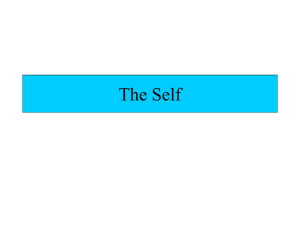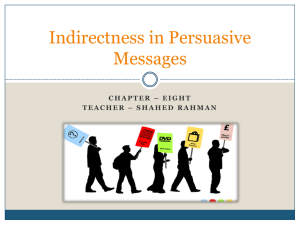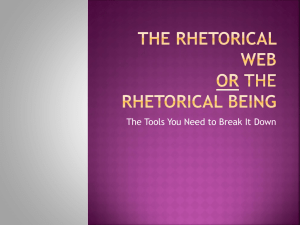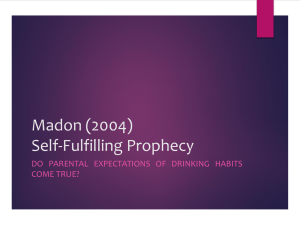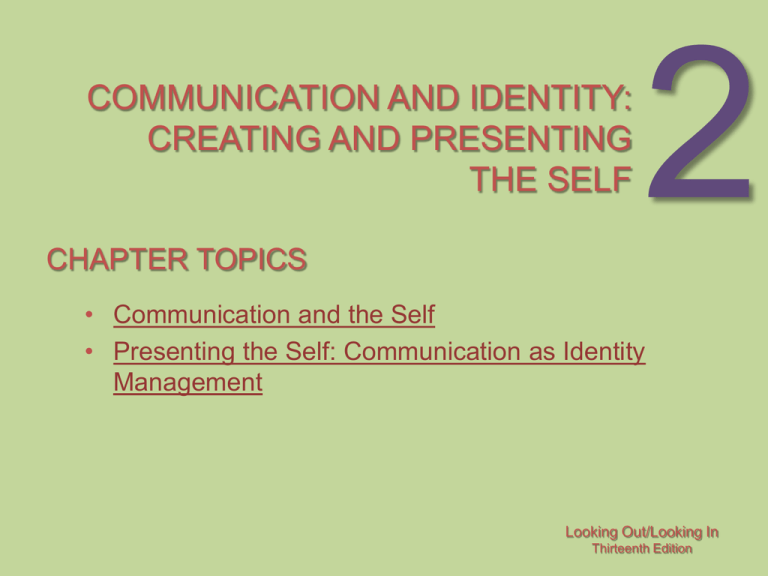
COMMUNICATION AND IDENTITY:
CREATING AND PRESENTING
THE SELF
2
CHAPTER TOPICS
• Communication and the Self
• Presenting the Self: Communication as Identity
Management
Looking Out/Looking In
Thirteenth Edition
Communication and the Self
• Self-Concept and Self-Esteem
• Self-concept
• The relatively stable set of perceptions you hold of
yourself
• Ask yourself, “Who am I ?”
• Describes who you think you are
• Self-esteem
• Evaluations of self-worth
• High self-esteem does not guarantee success
COMMUNICATION AND IDENTITY: CREATING AND PRESENTING THE SELF
2
Communication and the Self
• Self-Concept and Self-Esteem
• People with high self-esteem
•
•
•
•
•
•
Likely to think well of others
Expect to be accepted by others
Evaluate their own performance more favorably
Perform well when being watched
Inclined to feel comfortable with views of others
Able to defend themselves against negative
comments
COMMUNICATION AND IDENTITY: CREATING AND PRESENTING THE SELF
3
Communication and the Self
• Self-Concept and Self-Esteem
• People with low self-esteem
•
•
•
•
•
•
Likely to disapprove of others
Expect to be rejected by others
Evaluate their own performance less favorably
Perform poorly when being watched
Feel threatened by people they view as superior
Have difficulty defending themselves against
others’ negative comments
COMMUNICATION AND IDENTITY: CREATING AND PRESENTING THE SELF
4
Communication and the Self
• Self-Concept and Self-Esteem
• Self-esteem and communication behavior
Figure 2.1 Page 43
COMMUNICATION AND IDENTITY: CREATING AND PRESENTING THE SELF
5
Communication and the Self
• Biological and Social Roots to the Self
• Biology and the self
• Personality is part of our genetic makeup
• People who were judged shy as children still show a
reaction as adults when they encounter new situations
• Biology influenced traits
•
•
•
•
•
Extroversion
Shyness
Assertiveness
Verbal Aggression
Willingness to communicate
COMMUNICATION AND IDENTITY: CREATING AND PRESENTING THE SELF
6
Communication and the Self
• Socialization and the Self-Concept
• Reflected Appraisal
• Each of us develops a self-concept that reflects the
way we believe others see us
• Children are not born with a sense of identity
• Children are bombarded with messages
• “You’re so cute!” “I love you.” “What a big girl.”
• “What’s the matter with you?” “You’re a bad boy.”
• Evaluations like the those above are the mirror by
which we know ourselves
COMMUNICATION AND IDENTITY: CREATING AND PRESENTING THE SELF
7
Communication and the Self
• Socialization and the Self-Concept
• Social Comparison
• Evaluating ourselves in terms of how we compare
with others
• Two Types of Comparison
• Superior or Inferior
• Attractive or Ugly
• Success or Failure
• These comparisons depend on the person we
measure ourselves against
COMMUNICATION AND IDENTITY: CREATING AND PRESENTING THE SELF
8
Communication and the Self
• Socialization and the Self-Concept
• Social Comparison and The Media
• Young women who measure themselves against
ultra thin models develop negative appraisals
• Men who compare themselves to the mediaidealized male form develop negative appraisals
• TV makeover shows can lead viewers to feel
worse about themselves
COMMUNICATION AND IDENTITY: CREATING AND PRESENTING THE SELF
9
Communication and the Self
• Characteristics of the Self-Concept
• The self-concept is subjective
• Distorted self-evaluations can occur
• These distortions can be based on:
• Obsolete information
• Distorted feedback
• Emphasis on perfection
COMMUNICATION AND IDENTITY: CREATING AND PRESENTING THE SELF
10
Communication and the Self
• The Self-Concept Resists Change
• Cognitive Conservatism
• We seek out people who support our self-concept
• Are you funny? Or, do you surround yourself with people
who tell you that you’re funny?
• An inaccurate self-concept can lead to:
• Self-delusion
• Lack of growth
• Most communicators are reluctant to downgrade a
favorable impression of themselves
COMMUNICATION AND IDENTITY: CREATING AND PRESENTING THE SELF
11
Communication and the Self
• Culture, Gender, and Identity
• Culture
• Individualistic Culture
• Self is separate, unique individual
• Should be independent, self-sufficient
• Collectivistic Culture
• People belong to extended families or in-groups
• “We” or group orientation
COMMUNICATION AND IDENTITY: CREATING AND PRESENTING THE SELF
12
Communication and the Self
• Culture, Gender, and Identity
• Sex and gender
• Your gender shapes the way people communicate
with you
• Shaping children with language
• Boys – focus on size, strength and activity
• “What a big boy!” “Look at how strong.”
• Girls – focus on beauty and sweetness
• “She looks beautiful.” “You’re so sweet.”
COMMUNICATION AND IDENTITY: CREATING AND PRESENTING THE SELF
13
Communication and the Self
• The Self-Fulfilling Prophecy
• Self-fulfilling prophecy
• A person’s expectations and subsequent behavior
make an event more likely to occur
• Four stages of the self-fulfilling prophecy:
•
•
•
•
Holding an expectation (for yourself or others)
Behaving in accordance with that expectation
The expectation comes to pass
Reinforcing the original expectation
COMMUNICATION AND IDENTITY: CREATING AND PRESENTING THE SELF
14
Communication and the Self
• The Self-Fulfilling Prophecy
• Types of Self-Fulfilling Prophecies
• Self-imposed prophecies
• When your own expectations influence your behavior
• Prophecies imposed by others
• Expectations and behaviors of one, govern another’s
actions
• Pygmalion in the Classroom
• Teacher’s impact on students
• The selected students did better
COMMUNICATION AND IDENTITY: CREATING AND PRESENTING THE SELF
15
Communication and the Self
• Changing Your Self-Concept
•
•
•
•
Have a realistic perception of yourself
Have realistic expectations
Have the will to change
Have the skill to change
• Seek Advice
• Observe Models
COMMUNICATION AND IDENTITY: CREATING AND PRESENTING THE SELF
16
Communication as Identity
Management
• Public and Private Selves
• Perceived Self (Private)
• A reflection of the self concept
• Presenting Self (Public)
• The way we want others to
view us
COMMUNICATION AND IDENTITY: CREATING AND PRESENTING THE SELF
17
Communication as Identity
Management
• Constructing Multiple Identities
• Common Identities
•
•
•
•
Respectful Student
Joking Friend
Friendly Neighbor
Helpful Worker
• Constructing multiple identities is an element
of communication competence
COMMUNICATION AND IDENTITY: CREATING AND PRESENTING THE SELF
18
Communication as Identity
Management
• Identity Management:
• Is collaborative
• Can be deliberate or unconscious
• Varies by situation
• Differs in degree based on the individual
COMMUNICATION AND IDENTITY: CREATING AND PRESENTING THE SELF
19
Communication as Identity
Management
• Why Manage Identities
• We manage our identities to:
• Start and manage relationships
• Gain compliance of others
• Save the face of others
• We often modify the way we present ourselves to support
the way others want to be seen
• Explore new selves
COMMUNICATION AND IDENTITY: CREATING AND PRESENTING THE SELF
20
Communication as Identity
Management
• Why Manage Identities
• Face-to-face impression management
• Managed in three ways
• Manner
• Consists of a communicator’s words and nonverbal
actions
• Setting
• Physical items that we use to influence how others
view us
• Appearance
• Personal items used to shape an image
COMMUNICATION AND IDENTITY: CREATING AND PRESENTING THE SELF
21
Communication as Identity
Management
• Identity Management and Honesty
• Managing impressions doesn’t make you a
liar
• Each of us has a repertoire of faces
• Which face we choose to show to others is an
important decision
COMMUNICATION AND IDENTITY: CREATING AND PRESENTING THE SELF
22
Chapter Review
• Communication and the Self
• Self-Concept and Self-Esteem
• Biology, Culture, Gender, Identity
• Self-fulfilling Prophecy
• Presenting the Self: Communication as
Identity Management
• Public and Private Selves
• How and Why we Manage Identities
COMMUNICATION AND IDENTITY: CREATING AND PRESENTING THE SELF
23


